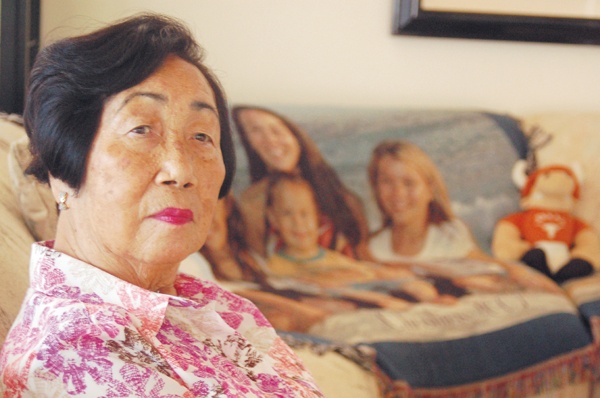OMAO — Takako Decker can still remember the day the last atomic bomb was dropped in Nagasaki on Aug. 9, 1945. The 83-year-old Koloa resident said she was only 15 years old at the time and was working inside a
OMAO — Takako Decker can still remember the day the last atomic bomb was dropped in Nagasaki on Aug. 9, 1945.
The 83-year-old Koloa resident said she was only 15 years old at the time and was working inside a secret ammunition factory on an island about 40 miles away from the city when she and other co-workers felt the ground and the building shake.
“All of the factory windows broke, so everybody said, ‘Something happened. There’s something wrong,’” said Decker, who was born and raised in Nagasaki. “We all ran outside and saw Nagasaki city — it looked like it was on fire. There was nothing but fire going on … and that’s when someone told me that there was a bomb that hit the city.”
But this bomb, she heard, was something different.
“This rumor came to say that Nagasaki city was all gone, because this bomb was so powerful,” Decker said. “We were told a lot of people died and houses were all burned up. I just thought, ‘Oh my gosh,’ because all of my high school friends and my family were still in the city.”
These are the memories, and side effects, that nearly 100 A-bomb survivors in Hawaii, including Decker, carry with them, according to Hawaii chapter of The American Society of Hiroshima-Nagasaki A-Bomb Survivors.
Mae Oda, a friend of A-bomb survivors, said Decker is one of only two known Kauai residents who are actively participating in a biennial event that provides free, comprehensive medical examinations for atomic bomb survivors from doctors based in Hiroshima, Japan, and resources from the atomic bomb survivors affairs office of the Hiroshima and Nagasaki prefecture governments.
Oda said the next round of examinations, scheduled for July 5 and 6 in Honolulu, are available for people who are legally defined in Japan to be survivors, including those who were within the city limits when the bombs fell, went into the city two weeks after the bombings, came in contact with other survivors while caring for them or were present at the bombing as an “in utero” baby.
Decker fits several of those categories, and has attended almost every screening since it was first offered in 1977 when she was living in Los Angeles.
She and her husband moved to Kauai after Hurricane Iniki in 1992 after they both retired from their jobs in the Los Angeles area.
In the nearly four decades since she first started attended the medical screenings, Decker said the visiting medical team has helped her identify possible thyroid trouble and obtain a hibakusha kenko techo booklet to officially certify her survivor status.
“I think that is it wonderful that the (Japanese) government is doing this,” Decker said.
“As people my age slowly pass away, the number of people who are going get smaller and smaller.”
In Nagasaki, she was one of the first people outside of the city to witness the devastation.
Decker, who was on one of the first boats to leave the factory, can still remember seeing dead bodies floating down the Urakami River and into the bay — the burned bodies of parched bomb survivors, who tried to quench their thirst by drinking from the radiated river.
“You won’t believe how powerful (the bomb) was,” Decker said.
“You had to be there to believe it.”
But Decker said she was one of the lucky ones and could still see her hillside house standing from the harbor.
She ran home and found her mother, sister-in-law and two nieces huddling next to the front door of their home alive, but visibly shaken and shocked.
“I was so happy to see that they were OK,” Decker said. “I was so lucky.”
These memories, however, are still difficult for her.
She can still remember seeing her neighbor, a young boy, walk home with severe burns to more than half his face — the result of seeing the bomb go off.
She remembers seeing dead bodies along the road to the train station in Nagasaki as she, her mother, her brother and two nieces evacuated three days after the bombing — bound for her uncle’s home in Saga.
She remembers the cruel treatment her brother received from those who mistook his lung condition for tuberculosis symptoms.
And she remembers having to cremate her brother’s body several weeks later in the front yard of her home in Nagasaki after he died from radiation exposure.
But, through it all, Decker says that she feels fortunate to have survived it all with few health problems. Her two nieces, she said, still live in Nagasaki to this day.
“It’s a sad story,” Decker said, “but I can’t help it — I have to tell the truth.”
For details about the screenings, call Oda at 861-2409.
• Darin Moriki, staff writer and photographer, can be reached at 245-3681 or dmoriki@thegardenisland.com.


